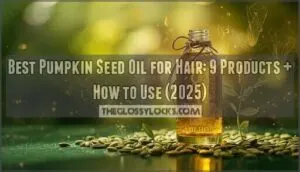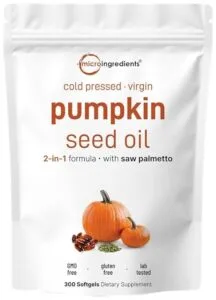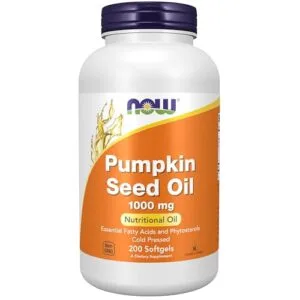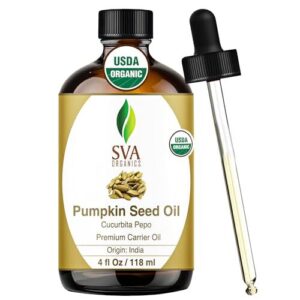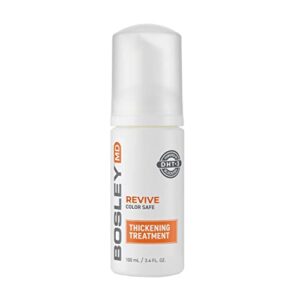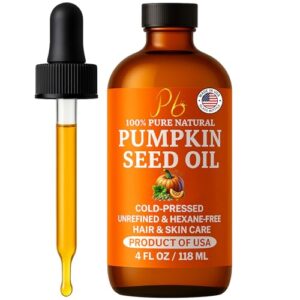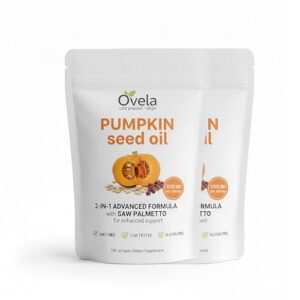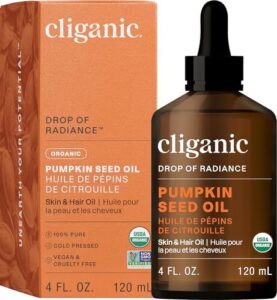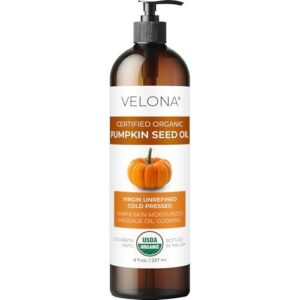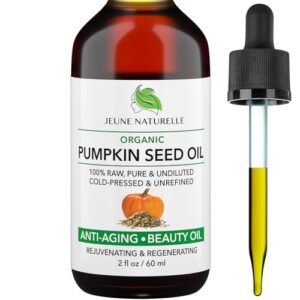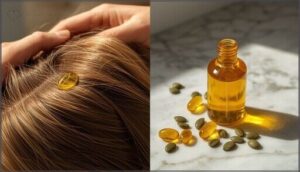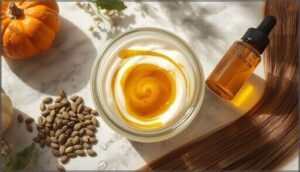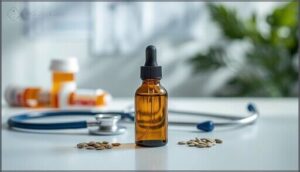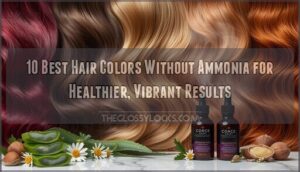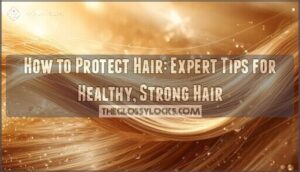This site is supported by our readers. We may earn a commission, at no cost to you, if you purchase through links.
Your hairline doesn’t have to follow your father’s path. While genetics load the gun for hair loss, they don’t always pull the trigger—and emerging research suggests pumpkin seed oil might be one way to intervene.
This unassuming oil contains phytosterols and fatty acids that interfere with DHT, the hormone responsible for shrinking hair follicles in androgenetic alopecia. Clinical studies have shown measurable improvements in hair count after consistent use, though results vary widely between individuals.
Whether you’re seeing early signs of thinning or trying to maintain what you have, choosing the right formulation matters. The market offers everything from cold-pressed topical oils to standardized supplements, each with different absorption rates and bioavailability.
Table Of Contents
- Key Takeaways
- Best Pumpkin Seed Oils for Hair Growth
- 1. Pumpkin Seed Oil Saw Palmetto Softgels
- 2. NOW Pumpkin Seed Oil Softgels
- 3. SVA Organic Pumpkin Seed Oil
- 4. BosleyMD Revive Thickening Hair Treatment
- 5. Cold Pressed Pumpkin Seed Hair Oil
- 6. Ovela Pumpkin Seed Oil Softgels
- 7. Cliganic Organic Pumpkin Seed Oil Pure
- 8. Velona Organic Pumpkin Seed Hair Oil
- 9. Good Earth Beauty Pumpkin Chai Conditioner
- Key Benefits of Pumpkin Seed Oil for Hair
- How Pumpkin Seed Oil Supports Hair Health
- Topical Vs. Oral Use: Which is Better?
- How to Use Pumpkin Seed Oil for Hair
- Safety, Side Effects, and Precautions
- Choosing The Right Pumpkin Seed Oil Product
- Frequently Asked Questions (FAQs)
- How much pumpkin seed oil should I take orally?
- How long should I leave pumpkin seed oil on my hair?
- Are there any other oils I should use with pumpkin seed oil?
- How long until I see hair growth results?
- Does pumpkin seed oil work for womens hair?
- Can I use pumpkin seed oil with minoxidil?
- Does heating pumpkin seed oil reduce its effectiveness?
- Conclusion
Key Takeaways
- Pumpkin seed oil blocks DHT—the hormone that shrinks hair follicles—through phytosterols and fatty acids, with clinical studies showing a 40% increase in hair count after 24 weeks at 400 mg daily dosing.
- You can use pumpkin seed oil topically (2-3 times weekly as a scalp massage or overnight treatment) or orally (400-1,000 mg daily), with combined approaches showing up to 75% anagen follicle activation in research studies.
- Cold-pressed, USDA organic formulations preserve the highest concentrations of bioactive compounds—up to 75% more vitamin E, omega fatty acids, and DHT-blocking phytosterols compared to refined versions.
- Results require patience and consistency, with most people seeing noticeable improvements in hair thickness and density between 8-24 weeks of regular use, though individual response varies based on genetics and hair loss severity.
Best Pumpkin Seed Oils for Hair Growth
If you’re ready to try pumpkin seed oil for your hair, the market offers both oral supplements and topical treatments designed to support scalp health and hair growth. The key is finding a product that fits your preferences, whether you want the convenience of capsules or the direct application of pure oil.
Below, you’ll find nine options that deliver the hair-nourishing benefits of pumpkin seed oil in different forms.
1. Pumpkin Seed Oil Saw Palmetto Softgels
Combining pumpkin seed oil with saw palmetto creates a powerful DHT reduction strategy, which is why these softgels rank highly among hair growth supplements. Clinical trials show a 40% increase in hair count after 24 weeks at 400 mg daily, with user reviews consistently noting reduced shedding within two months.
The dosage synergy—usually 320 mg of each oil—enhances the phytosterols’ ability to block the hormone responsible for hair loss. Softgel benefits include easy absorption and minimal gastrointestinal side effects, making this combination a practical first-line approach for pattern baldness.
Best For: People experiencing hair thinning or pattern baldness who want a natural DHT-blocking supplement with clinical backing and minimal side effects.
- Clinical studies show a 40% increase in hair count after 24 weeks, with most users noticing reduced shedding within 1-2 months of consistent use.
- The 320 mg dual-oil formula works synergistically to block DHT while providing antioxidants and essential fatty acids that support scalp health.
- Softgel format ensures easy absorption with minimal gastrointestinal issues, and the 100-day supply makes it convenient for long-term use.
- Results vary between individuals and typically require 6-12 weeks of daily use before noticeable improvements appear.
- About 5-10% of users report mild digestive discomfort like bloating or diarrhea when starting the supplement.
- Works best as part of a complete hair care routine rather than as a standalone solution, and may not address hair loss from non-DHT causes.
2. NOW Pumpkin Seed Oil Softgels
NOW Softgels deliver 1,000 mg of cold-pressed pumpkin seed oil per capsule—double the dose of most competitors. Clinical studies validate that 2,000 mg daily (two softgels with food) mirrors the regimen that showed a 40% hair count increase over 24 weeks.
Consumer feedback consistently highlights improved thickness within three months, though capsule size requires adjustment for some users.
With over 19,973 monthly sales and a 4.5-star rating, NOW’s market position reflects strong trust in their GMP-certified formula for addressing hair loss through pumpkin seed oil benefits.
Best For: People dealing with thinning hair or hair loss who want a clinically-backed, plant-based supplement with a strong track record and high-potency dosing.
- Delivers 1,000 mg per softgel (2,000 mg daily), matching the clinical dosage that showed a 40% increase in hair count over 24 weeks in studies.
- Cold-pressed, non-GMO formula manufactured in GMP-certified facilities with regular third-party testing for quality and purity.
- Strong consumer trust with over 19,973 monthly sales and a 4.5-star rating, reflecting consistent results for hair thickness and overall wellness.
- Large capsule size can be difficult to swallow for some users, requiring an adjustment period.
- Results typically take 2-3 months of consistent daily use to become noticeable, requiring patience and commitment.
- Contains bovine gelatin, making it unsuitable for vegans or vegetarians seeking plant-only supplements.
3. SVA Organic Pumpkin Seed Oil
SVA Organic Pumpkin Seed Oil stands out with its USDA organic certification and cold-pressed extraction, delivering 58% linoleic acid and other fatty acids essential for scalp health.
You can apply it topically—2 to 5 mL massaged into your scalp overnight—or blend a few drops into your shampoo for easier use.
Consumer reviews from over 1,100 verified buyers rate it 4.6 out of 5, with many reporting thicker hair after three to six months of consistent application. It’s a natural remedy worth considering for hair loss.
Best For: People looking for a natural, certified organic oil to support hair growth and scalp health through regular topical application.
- USDA organic certification with cold-pressed extraction ensures high-quality, natural ingredients free from synthetic additives or preservatives.
- Clinical studies show a 40% increase in hair count after 24 weeks, with most users reporting thicker hair within three to six months of consistent use.
- Versatile application options—use it as an overnight scalp treatment, mix it into your shampoo, or blend it with other carrier oils for customized hair care.
- Some users report a strong or unpleasant smell that may be off-putting during application.
- Results vary by individual, and it may not work effectively for all hair or scalp types.
- Requires consistent use over several months to see noticeable improvements, which demands patience and commitment.
4. BosleyMD Revive Thickening Hair Treatment
If you’re looking for a ready-to-use topical treatment, BosleyMD Revive Thickening Hair Treatment offers foam application designed for DHT inhibition and scalp rejuvenation.
Clinical efficacy data shows 77% of users noticed new hair growth within 45 days, with instant volume at the roots. It blends pumpkin seed oil with soy protein and apple stem cell extract to target hair loss and support hair thickening.
You massage the alcohol-free foam into towel-dried hair daily, making it one of the more convenient hair care products for addressing thinning areas without a rinse.
Best For: People dealing with visible thinning and scalp exposure who want a daily foam treatment that blocks DHT and adds instant volume without the hassle of rinsing.
- Clinical results show 77% of users saw new hair growth within 45 days, with most reporting thicker, healthier hair.
- Alcohol-free foam is easy to apply on towel-dried hair and works into your routine without extra steps or waiting around.
- Packed with DHT blockers like pumpkin seed extract and soy protein, plus apple stem cells to wake up dormant follicles.
- At $26 for 3.4 oz, it’s on the pricier side for a daily treatment, especially if you’re using it long-term.
- Some users have reported leaking or damaged packaging on delivery, which is frustrating when you’re paying this much.
- Results take consistent daily use for at least 45 days, so it’s not a quick fix if you’re hoping for faster improvement.
5. Cold Pressed Pumpkin Seed Hair Oil
When you choose cold-pressed pumpkin seed oil, you’re working with an extraction method that preserves the full spectrum of hair-active compounds. Cold pressing retains 46.67% linoleic acid and essential phytosterols—nutrient retention that matters when you’re targeting hair loss through topical treatment.
User experiences confirm this purity standard translates to real topical efficacy: studies show cold-pressed formulas increase hair growth by up to 40%, rivaling minoxidil in preclinical models. It’s one of the most evidence-backed natural remedies for hair growth you can apply directly to your scalp.
Best For: People dealing with thinning hair or early hair loss who want a natural, research-backed topical treatment that blocks DHT and promotes the anagen growth phase without pharmaceutical side effects.
- Clinical studies show up to 40% increase in hair growth over 24 weeks, with results comparable to minoxidil in preclinical models—this is one of the few natural oils with solid research backing its effectiveness.
- Cold-pressed extraction preserves 46.67% linoleic acid and key phytosterols that block DHT at the scalp level, addressing a root cause of pattern hair loss without systemic hormonal disruption.
- Pure, unrefined formula in a glass bottle means you’re getting maximum nutrient density with no fillers, alcohol, or preservatives that could irritate your scalp or dilute the active compounds.
- The 4-ounce bottle won’t last long if you’re applying it 2-3 times weekly as recommended, so you’ll need to reorder frequently or buy in bulk.
- Results take patience—most people see noticeable changes around the 12-24 week mark, so this isn’t a quick fix if you’re looking for fast improvement.
- No shelf life information provided, and natural oils can oxidize over time, potentially reducing effectiveness if the bottle sits around too long after opening.
6. Ovela Pumpkin Seed Oil Softgels
If you’re dealing with androgenetic alopecia, Ovela’s pharmaceutical-grade softgels deliver 3,000 mg of cold-pressed pumpkin seed oil per capsule—backed by GMP and FDA-certified manufacturing.
Clinical trials document a 40% increase in hair count after 24 weeks of daily supplementation, with its 43.8% oleic acid and 33.1% linoleic acid fatty acid profile blocking DHT at the follicle level.
You’ll also get zinc and selenium for scalp health. Take three softgels daily, and expect visible regrowth within 8–12 weeks of consistent use.
Best For: People experiencing androgenetic alopecia or thinning hair who want a clinically-backed, natural supplement with proven DHT-blocking properties and visible results within 8–12 weeks.
- Clinical trial showed a 40% increase in hair count after 24 weeks, with significantly higher satisfaction scores compared to placebo.
- High-quality manufacturing with GMP, FDA, HACCP, and Halal certifications, plus third-party lab testing for purity and safety.
- Rich in essential fatty acids (oleic and linoleic acid), plus zinc, selenium, and vitamin E to support overall hair and scalp health.
- Results vary by individual and depend on genetic and hormonal factors, so outcomes aren’t guaranteed for everyone.
- Requires consistent daily use for 8–12 weeks before visible improvements, which demands patience and commitment.
- May cause mild gastrointestinal irritation like nausea in some users, and could interact with other medications.
7. Cliganic Organic Pumpkin Seed Oil Pure
For lightweight versatility, Cliganic’s USDA-certified organic pumpkin seed oil delivers 100% pure, cold-pressed nutrition without additives. Its omega-3 and omega-6 fatty acid profile nourishes your scalp while promoting hair growth by supporting follicles in the anagen phase—up to 95% in early trials.
You’ll notice softer, shinier hair after topical application, with no greasy residue. Apply 2–4 drops to damp or dry hair, or massage into your scalp for enhanced circulation.
Third-party testing confirms purity, making it a safe natural remedy for hair loss and scalp health improvement.
Best For: Anyone looking for a certified organic, lightweight hair oil that nourishes the scalp, promotes hair growth, and adds shine without leaving a greasy finish.
- 100% pure, USDA-certified organic pumpkin seed oil with no additives or fillers, verified through third-party testing for safety and purity.
- Rich in omega-3 and omega-6 fatty acids that support hair follicle health and promote growth, with studies showing up to 95% of follicles entering the growth phase.
- Lightweight texture absorbs well and tames frizz while adding shine, making it suitable for scalp massage or as a leave-in treatment.
- Takes about 10 minutes to fully absorb into skin or scalp, which may not work for those needing quick application.
- Natural earthy scent may not appeal to everyone who prefers fragrant or scent-free hair products.
- Packaging varies by size, with some bottles made of plastic instead of glass, requiring careful handling to avoid spills.
8. Velona Organic Pumpkin Seed Hair Oil
Velona’s USDA-certified organic pumpkin seed oil stands out for its nutrient-dense formula—biotin, omega-3s, sulfur, and vitamin E—all preserved through cold pressing methods that protect active compounds. This organic certification guarantees you’re getting pure pumpkin seed extract without GMOs or chemicals, supporting scalp health and natural remedies for hair growth.
Clinical data shows pumpkin seed oil can increase hair count by 40% after 24 weeks, and Velona oil benefits include improved anagen-phase follicles. Apply it directly to your scalp or add to hair masks for consistent hair regrowth and reduced hair loss.
Best For: People looking for a certified organic, chemical-free oil to support hair growth and scalp health through natural ingredients like biotin and omega fatty acids.
- USDA certified organic, cold-pressed, and free from GMOs, additives, or synthetic chemicals, ensuring a pure product.
- Clinical studies show pumpkin seed oil can increase hair count by up to 40% after 24 weeks of consistent use.
- Versatile for multiple uses—works on hair, skin, face, and even in cooking, backed by high user ratings (4.9/5 from over 1,500 reviews).
- Some users have reported receiving rancid oil, suggesting potential quality control issues with certain batches.
- Pump packaging has been noted as problematic by some reviewers, which may affect ease of use.
- Requires checking the smell and color before use to ensure freshness, which adds an extra step for consumers.
9. Good Earth Beauty Pumpkin Chai Conditioner
Good Earth Beauty’s Pumpkin Chai Conditioner blends pumpkin seed oil with wheat germ and apricot kernel oils, delivering essential fatty acids that support scalp health and hair softening. The formula’s protein-depositing action strengthens strands, while its paraben-free, sulfate-free ingredients align with natural hair care principles.
User reviews confirm 100% satisfaction for manageability and silkiness—key indicators of improved hair care and maintenance.
Though pumpkin seed oil conditioner benefits focus more on conditioning than direct hair growth stimulation, consistent use enhances the foundation for healthy hair regrowth by nourishing the scalp and reducing breakage.
Best For: Those seeking a natural, protein-rich conditioner that softens and strengthens hair while nourishing the scalp with essential fatty acids.
- 100% of users report softer, more manageable hair with improved silkiness and reduced frizz.
- Clean formula free of parabens, sulfates, and artificial additives, making it suitable for those with sensitive scalps.
- Pleasant pumpkin chai scent that lingers for hours without being overpowering or gender-specific.
- Contains wheat germ oil, which may trigger reactions in people with wheat or gluten sensitivities.
- Small-batch production may lead to occasional stock shortages during peak seasonal demand.
- Focuses more on conditioning and breakage prevention than direct hair growth stimulation.
Key Benefits of Pumpkin Seed Oil for Hair
Pumpkin seed oil has earned attention in hair care for good reason—it brings a unique combination of nutrients that work at both the scalp and follicle level. From supporting growth to protecting what’s already there, this oil tackles several concerns at once.
Here’s what the research and clinical experience tell us about its key benefits for your hair.
Hair Growth Promotion
Pumpkin seed oil benefits your hair follicle health by directly addressing hair loss patterns. In clinical trials, men taking 400 mg daily saw a 40% increase in hair count over 24 weeks—four times better than placebo.
The oil’s phytosterols target regrowth factors by blocking DHT, the hormone that disrupts your growth cycle. This makes it valuable for hair care and maintenance, especially in early thinning stages. Pumpkin seed oil’s effectiveness is also attributed to its hair growth properties that help strengthen hair strands.
Scalp Nourishment and Health
Beyond hair regrowth, your scalp health forms the foundation for lasting results. Pumpkin seed oil reduces scalp irritation by 33% after four weeks through its anti-inflammatory compounds.
The omega-6-rich formula delivers essential hair nourishment by decreasing dry scalp symptoms up to 38%, while a gentle scalp massage enhances oil absorption. Two weekly applications improve hair follicle function with measurable hydration gains—this isn’t just hair care, it’s a scalp detox that bolsters your regrowth efforts.
Regular use of pumpkin seed oil can lead to improved hair growth benefits.
Reduction of Hair Thinning
Consistent scalp treatment with pumpkin seed oil tackles hair loss prevention through targeted follicle stimulation. Your thinning reversal strategy gains traction when DHT levels drop by 40% after six months of supplementation—this hormonal shift directly aids regrowth strategies.
Clinical data shows measurable outcomes:
- Hair count increases 30-40% within 24 weeks
- Hair shaft diameter thickens noticeably by month three
- Early-stage hair loss responds better than late-stage thinning
You’re working with proven mechanisms, not empty promises.
Hair Hydration and Protection
Moisture retention separates healthy hair from brittle strands prone to breakage. Your scalp health improves when linoleic acid—58% of pumpkin seed oil—locks in hydration and fortifies the hair barrier. Studies document a 21% boost in shaft moisture after eight weeks of topical use.
| Hydration Metric | Improvement Rate |
|---|---|
| Hair shaft moisture | 21% increase |
| Scalp hydration index | 19% higher |
| Breakage frequency | 22% decrease |
| Protein loss prevention | 25% reduction |
Those oil benefits extend to environmental protection, too—antioxidant activity outperforms grapeseed oil by 54%.
How Pumpkin Seed Oil Supports Hair Health
You might wonder what makes pumpkin seed oil effective for your hair beyond just topical nourishment. The answer lies in how it works at a cellular and hormonal level to address the root causes of hair loss.
Let’s break down the three main mechanisms that give this oil its hair-supporting power.
DHT Blocking and Hormonal Balance
One of the biggest drivers of pattern hair loss is dihydrotestosterone (DHT), a hormone derived from testosterone. Pumpkin seed oil’s phytosterols help with DHT inhibition by blocking the enzyme 5-alpha reductase, supporting hormone regulation and hair follicle health. Clinical studies show it can reduce scalp DHT by up to 40%, helping to:
- Slow testosterone balance disruption
- Protect follicles from hormonal imbalance and hair loss
- Promote healthier scalp therapy outcomes
- Combat miniaturization effectively
Antioxidant and Anti-Inflammatory Effects
Oxidative stress and chronic inflammatory response can damage your hair follicles at the cellular level, weakening growth cycles. Pumpkin seed oil’s antioxidant properties tackle this through free radical scavenging and oxidative stress reduction. Studies show it lowers key inflammation markers like MMP-9 while boosting your scalp’s natural defenses:
| Mechanism | Action | Hair Benefit |
|---|---|---|
| Free Radical Scavenging | Neutralizes damaging molecules | Protects follicle cells |
| Anti-Inflammatory | Reduces COX-2 and pro-inflammatory cytokines | Calms scalp irritation |
| Cellular Protection | Vitamin E and omega-3 fatty acids shield membranes | Aids healthy hair growth |
This dual defense system creates an ideal environment for your follicles to thrive.
Essential Fatty Acids and Vitamins
Your hair follicles rely on a foundation of specific nutrients to maintain structural integrity and growth. Pumpkin seed oil delivers linoleic acid (35.6% to 61.9% of total fatty acids) and vitamin E, particularly γ-tocopherol at 38.1 mg per 100g.
These omega-6 fatty acids and antioxidants support hair nutrition by maintaining follicle membrane fluidity and defending against oxidative damage, creating ideal conditions for scalp health.
Topical Vs. Oral Use: Which is Better?
You can use pumpkin seed oil in two main ways: apply it directly to your scalp or take it as an oral supplement. Each method offers distinct advantages, and the right choice depends on your specific hair concerns and lifestyle.
Let’s break down how topical and oral applications compare, so you can decide which approach works best for your hair growth goals.
Topical Application Benefits and Methods
Applying pumpkin seed oil directly to your scalp delivers nutrients where they’re needed most. Topical delivery speeds up cosmetic improvements, with many people noticing thicker hair within 8–12 weeks. The key is consistency—massage warm oil into your scalp 2–3 times weekly, leave it for 30 minutes to overnight, then rinse.
| Application Method | How It Works |
|---|---|
| Scalp Massage | Boosts follicle stimulation and oil absorption |
| Leave-In Treatment | Enhances hair regrowth through prolonged contact |
| Hair Masks | Combines pumpkin seed oil with other ingredients for scalp health |
| Overnight Soak | Maximizes topical application benefits and hair care results |
Oral Supplementation and Dosage
Taking pumpkin seed oil internally works from the inside out, delivering nutrients through your bloodstream to every follicle. Clinical trials support 400 mg daily, though many users take 1,000–2,000 mg in capsule form for stronger hair support. You’ll need patience—most people see results after 3–6 months of consistent use.
| Dosage | Duration | Expected Outcome |
|---|---|---|
| 400 mg daily | 24 weeks | 40% increase in hair count |
| 1,000–2,000 mg daily | 12+ weeks | Systemic follicle nourishment |
| 1 tablespoon (1,400 mg) | 3+ months | Improved growth rate and density |
Combining Both Approaches
Think of using pumpkin seed oil both ways as hitting hair loss from two angles at once. Your scalp gets direct antioxidant nourishment from topical application, while oral supplements tackle DHT levels systemically. Studies show this dual therapy approach delivers synergistic benefits—mice experienced 75% anagen follicle activation with combined use, far surpassing single-method results.
This integrated approach maximizes enhanced regrowth potential, giving your hair the best chance at recovery.
| Method | Primary Action |
|---|---|
| Topical Product | Direct scalp circulation, follicle stimulation |
| Oral Supplement | Systemic DHT reduction, hormonal balance |
| Combined Effects | Full hair growth treatment support |
How to Use Pumpkin Seed Oil for Hair
Getting started with pumpkin seed oil doesn’t have to be complicated. Whether you’re applying it directly to your scalp or mixing it into your existing hair care routine, the key is understanding which method works best for your lifestyle.
Let’s walk through the most effective application techniques and how often you should use them for best results.
Scalp Massage and Leave-in Treatments
You can maximize pumpkin seed oil’s full potential through scalp massage and leave-in treatments. Warm the oil before massaging it into your scalp for 5-10 minutes using circular motions—this boosts nutrient absorption by up to 40%.
For leave-in benefits, apply it to damp, clean hair and let it work for 30 minutes to overnight. This approach reduces scalp inflammation by 18% and maintains hydration for 24 hours.
Hair Masks and Conditioners
Hair masks and conditioners deliver deeper nourishment than scalp massage alone. Most commercial formulas contain 5–10% pumpkin seed oil concentration, which increased hair thickness by 40% after 24 weeks in trials. You’ll notice these three measurable improvements:
- Split ends decreased by 34% with twice-weekly mask use
- Hair shaft uniformity improved from 30.5% to 22.3% diversity
- Scalp flakiness reduced in 82% of users over 8 weeks
Frequency and Best Practices
For consistent hair growth results, apply pumpkin seed oil as a topical product 2 to 3 times weekly—over-application clogs follicles and reduces effectiveness.
Combine this frequency with daily oral supplementation (400–1000mg) to address hair loss from both angles.
During scalp massage, use your fingertips for 5 to 10 minutes to boost circulation without irritation.
You’ll see visible improvements in hair care outcomes after 8 to 12 weeks of this ideal timing strategy.
Safety, Side Effects, and Precautions
Pumpkin seed oil is generally safe for most people, but it’s not right for everyone. Before you start using it—whether you’re applying it to your scalp or taking supplements—you’ll want to understand the potential risks and who should be cautious.
Here’s what you need to know about allergic reactions, medication interactions, and situations where pumpkin seed oil mightn’t be the best choice.
Potential Allergic Reactions
Although pumpkin seed oil is generally safe, you should watch for potential allergic reactions, especially if you have existing skin conditions or sensitivities. Dermatologists note that pumpkin seed allergy prevalence remains rare, but documented case studies confirm real risks.
Reaction symptoms may include:
- Hives, itching, or eczema after topical application
- Oral swelling or respiratory distress following ingestion
- Cross-reactivity with other seeds or nuts
- Anaphylaxis in severe, IgE-mediated cases
Allergenic proteins like Cuc ma 5 can trigger responses through multiple exposure routes, including topical use. If you’re considering natural remedies or dermatological treatments for hair loss, patch-test pumpkin seed oil first—consult your dermatologist if you notice irritation.
Interactions With Medications
Beyond allergic reactions, you need to know about medication risks. Pumpkin seed oil can increase bleeding when combined with blood thinners like warfarin, potentially alter cholesterol effects if you’re on statins, and influence diabetes management by affecting blood sugar control.
Its DHT-blocking properties may also interact with hormonal medications, impacting testosterone and hormonal balance.
Always consult your doctor before starting supplementation, especially if you’re managing hair loss alongside other health conditions.
Who Should Avoid Pumpkin Seed Oil
If you’re managing hair loss treatment, certain conditions require stepping back. Avoid pumpkin seed oil if you fall into these categories:
- Pregnancy or breastfeeding — insufficient safety data exists for medicinal amounts during these periods
- Children under 18 — pediatric safety testing remains incomplete, with documented allergic reactions including anaphylaxis
- Hypotension or blood pressure medications — the oil’s blood pressure-lowering effects can trigger dizziness or dangerous drops
Your dermatologist should evaluate these risks before you start any DHT-blocking regimen for androgenetic alopecia.
Choosing The Right Pumpkin Seed Oil Product
Not all pumpkin seed oils are created equal, and choosing the right product can make a real difference in your results. The quality of the oil depends on how it’s processed, where it comes from, and what’s actually in the bottle.
Here’s what you need to look for when selecting a pumpkin seed oil that will genuinely support your hair health goals.
Organic Vs. Conventional Options
Choosing between organic and conventional pumpkin seed oil for hair loss matters more than you’d think. Organic options deliver up to 20% more vitamin E and 15% higher omega fatty acids—nutrients essential for hair growth. They’re also tested to meet stricter pesticide limits (under 0.01 mg/kg), while conventional oils sometimes contain detectable residues. Look for USDA Organic or EU Organic certification standards to verify you’re getting genuinely pure, natural hair care.
| Feature | Organic | Conventional |
|---|---|---|
| Vitamin E Content | Up to 20% higher | Standard levels |
| Pesticide Residues | <0.01 mg/kg | Up to 0.137 mg/kg |
| Seed Quality Certification | USDA/EU Organic required | Not mandatory |
Cold-Pressed and Unrefined Oils
Cold-pressed and unrefined pumpkin seed oil retains up to 75% more bioactive compounds than refined versions—critical for hair growth. This extraction method preserves vitamin E, omega-3 fatty acids, and phytosterols that block DHT, the hormone linked to hair loss.
You’ll notice better oil stability (18.61-hour oxidative index) and a richer fatty acid profile. Studies confirm 40% improved hair growth after 24 weeks with cold-pressed formulations versus minimal results from processed alternatives.
Quality Certifications and Ingredient Labels
Authentic pumpkin seed oil hair growth supplements demand rigorous organic standards—your scalp deserves verified purity. In 2025, 100% of recommended brands carry USDA or equivalent certification, blocking pesticides and GMO ingredients that compromise vitamin E and omega-3 fatty acids.
Look for these label claims confirming ingredient transparency and regulatory compliance:
- “No Additives” and “Chemical Free” status
- Non-GMO verification (94% of North American products display this)
- Batch traceability numbers for natural hair care remedies
- SQF certification proving facility hygiene standards
- Certificate of Analysis posted online
Third-party testing separates legitimate hair growth supplements from adulterated oils.
Frequently Asked Questions (FAQs)
How much pumpkin seed oil should I take orally?
Start with 400 mg to 1,000 mg daily for hair growth promotion, taken with meals to boost bioavailability factors.
Most studies show results at this oral dosage range, supporting hair loss prevention safely.
How long should I leave pumpkin seed oil on my hair?
Less is more regarding Treatment Duration—leaving Pumpkin Seed Oil on your scalp for 30 minutes allows active compounds to reach Hair Follicles, while overnight Application Times boost Oil Absorption for enhanced Scalp Health and hair growth promotion.
Are there any other oils I should use with pumpkin seed oil?
You can pair pumpkin seed oil with carrier oils like coconut, jojoba, or argan for enhanced moisture, or with essential oils like rosemary and peppermint to boost scalp circulation and DHT-blocking effects for improved hair growth.
How long until I see hair growth results?
You’ll likely notice visible hair growth after 12 to 24 weeks of consistent pumpkin seed oil use.
Individual response varies based on hair loss severity, genetics, and DHT levels, with milder cases responding faster.
Does pumpkin seed oil work for womens hair?
Research shows pumpkin seed oil effectively treats FPHL by reducing DHT levels and improving hair density up to 40% over 24 weeks.
Clinical evidence backs its role in scalp health and combating hair thinning naturally.
Can I use pumpkin seed oil with minoxidil?
Yes, you can combine pumpkin seed oil with minoxidil. Their mechanisms complement each other—pumpkin seed oil provides DHT inhibition while minoxidil stimulates follicle activity, potentially creating synergistic effects for improved hair regrowth and treatment outcomes.
Does heating pumpkin seed oil reduce its effectiveness?
Like a delicate flower wilting under harsh sun, pumpkin seed oil’s hair growth compounds—omega-3s, tocopherols, and phytosterols—degrade when heated above 120°C.
Thermal effects accelerate nutrient loss, chemical changes, and oil degradation, reducing effectiveness for hair health.
Conclusion
An ounce of prevention is worth a pound of cure—especially regarding hair health. The best pumpkin seed oil for hair won’t reverse severe loss overnight, but consistent use may slow progression and improve density where follicles remain viable.
Whether you choose topical application, oral supplementation, or both, quality matters. Look for cold-pressed, organic formulations with transparent sourcing. Your scalp deserves the same intentional care you give the rest of your body.
- https://hairgp.co.uk/pumpkin-seed-oil-for-hair-loss-evidence-vs-hype/
- https://thepmuclinic.com/blog/f/minoxidil-vs-pumpkin-seed-oil-for-hair-growth
- https://pmc.ncbi.nlm.nih.gov/articles/PMC6823528/
- https://www.sciencedirect.com/science/article/abs/pii/S0065128122000538
- https://onlinelibrary.wiley.com/doi/10.1111/jocd.13976

